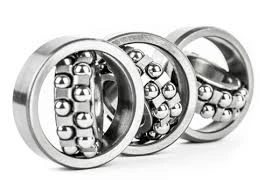
nov. . 11, 2024 02:50 Back to list
Exploring the Role of Ball Bearings in Minimizing Friction in Mechanical Systems
How Do Ball Bearings Reduce Friction in Machinery?
Ball bearings are an essential component in many machines and mechanical systems, playing a key role in facilitating smooth movement and reducing friction. Understanding how ball bearings function and why they are so effective in minimizing friction can provide valuable insights into their importance in engineering and technology.
The Basics of Ball Bearings
A ball bearing consists of a series of small, spherical balls that are positioned between two smooth surfaces, typically referred to as the inner and outer races. These races create a track along which the balls can roll. The primary purpose of a ball bearing is to support radial and axial loads while minimizing friction during motion. The effectiveness of ball bearings arises from their unique design and the fundamental principles of physics.
Mechanisms of Friction Reduction
Friction is the resistance that one surface or object encounters when moving over another. In machinery, excessive friction can lead to increased wear and tear, energy loss, and heat generation. Ball bearings significantly reduce friction through several mechanisms
1. Rolling Friction vs. Sliding Friction One of the main reasons ball bearings are used is that they convert sliding friction into rolling friction. When two surfaces slide against each other, the frictional force is much higher compared to when an object rolls. The rolling action of the balls allows for easier movement between the surfaces, drastically reducing the amount of energy lost to friction.
2. Distribution of Load Ball bearings evenly distribute the weight and load across the surface area of the balls and races. This distribution minimizes the pressure on any single point, reducing the chances of deformation in the surfaces, which can create additional friction.
how do ball bearing reduce friction in machinery

3. Reduced Surface Contact In a traditional sliding system, the entire surface area is in contact, leading to higher friction. With ball bearings, only a limited surface area is in contact with the races at any given moment, which means less surface area contributes to friction.
4. Lubrication Ball bearings often operate with lubricants, such as oil or grease, which further reduce friction. The lubricant forms a film between the balls and the races, minimizing direct contact and providing a smooth interface for motion. This lubrication not only assists in friction reduction but also prevents wear and corrosion of the bearing surfaces.
Application Across Industries
Ball bearings are used in a wide variety of applications across multiple industries. From the humble bicycle and bedroom ceiling fans to high-speed train systems and advanced aerospace technology, their ability to reduce friction and enhance performance makes them indispensable. For instance, in electric motors, ball bearings help maintain efficiency by reducing energy loss due to friction, which can lead to overheating and decreased performance.
Longevity and Maintenance
While ball bearings are designed to last, their efficiency can be impacted by factors like contamination, lack of lubrication, and wear over time. Regular maintenance, including proper lubrication and inspection for wear, is crucial to ensure they function optimally. In many industrial settings, automated lubrication systems are employed to ensure that bearings are continually supplied with the necessary lubricant, keeping friction to a minimum and extending their lifespan.
Conclusion
In summary, ball bearings significantly reduce friction in machinery through their rolling motion, effective load distribution, reduced contact area, and the use of lubrication. Their application is vast and spans various industries, underscoring their importance in engineering design. By minimizing friction, ball bearings not only enhance the efficiency of machines but also lead to improved performance and longevity. As technology continues to evolve, it is likely that innovations in bearing design and materials will further optimize their performance and usability in even more complex and demanding applications.
Latest news
-
Grooved Ball Bearing Design and Functionality
NewsJun.04,2025
-
Concrete Mixer Bearing Load Capacity Testing
NewsJun.04,2025
-
6004 Bearing Dimensions in Robotic Joint Designs
NewsJun.04,2025
-
Advantages of Single-Row Deep Groove Ball Bearings
NewsJun.04,2025
-
Applications of Deep Groove Ball Bearings in Automotive Systems
NewsJun.04,2025
-
Innovations in Bearing Pressing Machine Design
NewsJun.04,2025
